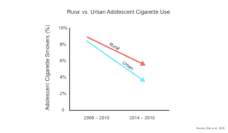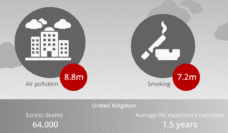Smoking during pregnancy can lead to serious health consequences for women and their babies. Given the risks, understanding the factors that influence maternal smoking during pregnancy is critical. In the United States, 10.7% of pregnant women smoke, though prevalence varies by region.
The neighborhood in which a woman lives may influence whether or not she smokes. Certain factors that compose a neighborhood, specifically median income and the density of stores that sell tobacco, are associated with negative health behaviors (smoking and inability to quit smoking) and health outcomes (lower life expectancy). Understanding the factors that influence tobacco use may provide insight into helping women avoid smoking before they become pregnant and assisting them to stop once they become pregnant.
Recently, we studied the relationship between tobacco store density, neighborhood socioeconomic status, and smoking during pregnancy. We found that high tobacco store density of a neighborhood, independent of neighborhood median income and racial composition, was associated with higher smoking rates for pregnant women living in Baltimore City. Ours is the first study to demonstrate the association between the clustering of tobacco retail outlets and smoking patterns of pregnant women. In our final adjusted model, for every one unit increase in tobacco store density per 10,000 persons, we found a 10% increase in women smoking while pregnant.
We found that high tobacco store density of a neighborhood, independent of neighborhood median income and racial composition, was associated with higher smoking rates for pregnant women living in Baltimore City.
Nicotine addiction worsens during pregnancy due to hormonal impacts on the CYP2A6 enzyme (responsible for nicotine addiction). Therefore, pregnant women often smoke more. The proximity of tobacco retail outlets likely contributes to ongoing smoking and creates challenges for quitting.
From a public health perspective, reducing neighborhood tobacco store density may curb smoking during pregnancy. Regulation of alcohol outlets in communities has been shown to decrease residents’ alcohol use. Implementing similar tobacco density regulations would allow us to measure the impact on smoking habits of all community members, including pregnant women. Successful reductions in smoking prevalence would be in accordance with the Family Smoking Prevention and Tobacco Control act of 2009, created to promote future public health policies related to tobacco sales for the United States. Public health policies to reduce tobacco store density in communities would also extend laws impacting tobacco access and use. Advocacy for policies regulating tobacco store distribution in neighborhoods and communities will help us achieve public health tobacco-related goals.
Photo via Getty Images














